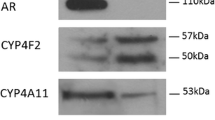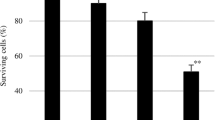Summary
Culturing human prostate PC-3 cells for 4, 24, or 72 h in the presence of 5,8,11,14-eicosatetraynoic acid (ETYA), an inhibitor of arachidonic acid metabolism and cholesterol biosynthesis, markedly altered the morphology and reduced the number of mitochondria in the treated cells. Using quantitative electron microscopic morphometry, we documented changes in the number, form, area, matrix density, and integrity of the cristae and limiting membranes of mitochondria in cells cultured with ETYA. The inhibition of cholesterol synthesis or the substitution of ETYA for polyunsaturated fatty acids in the inner membrane may participate in the disruption of the mitochondria, which resembles the morphologic sequelae of oxidative stress. If sufficiently extensive, these changes could contribute to the inhibition of cellular proliferation by ETYA.
Similar content being viewed by others
References
Anderson, K. M.; Ondrey, F.; Harris, J. E. Induction of monocyte like but not of macrophage morphology in U937 cells cultured with 5,8,11,10-eicosatetraynoic acid, a competitive inhibitor of arachidonic acid metabolism. Ann. Clin. Lab. Sci. 10:92–100; 1988.
Anderson, K. M.; Seed, T. M.; Ondrey, F., et al. Tumor mitochondrial matrix/cristae complexes as potential sites for anticancer therapy with polyunsaturated fatty acid analogs. Prostaglandins Leukotriens 40:137–141; 1990.
Anderson, K. M.; Wygodny, J. B.; Ondrey, F., et al. Human PC-3 prostate cell line DNA synthesis is suppressed by eicosatetraynoic acid, an in vitro inhibitor of arachidonic acid metabolism. Prostate 12:3–12; 1988.
Begin, M. E.; Ells, G.; Horrobin, D. F. Polyunsaturated fatty acid induced cytotoxicity against tumor cells and its relationship to lipid peroxidation. JNCI 80:188–193; 1987.
Cerutti, P. A. Proxidant states and tumor promotion. Science 227:375–381; 1985.
Ghadially, F. N. Mitochondria. In: Ultrastructural pathology of the cell and matrix. London: Butterworth; 1982:149–263.
Harris, J. E.; Anderson, K. M.; Ondrey, F., et al. Evidence of oxidative stress of ETYA (5,8,11,14-eicosatetraynoic acid) treated replication-arrested human prostate (PC-3) cells and its absence in replication-arrested human U937 monoblastoid cells. Proc. Am. Assoc. Cancer Res. 30:203; 1989.
Kaighn, M. E.; Narayan, K. S.; Ohnuki, Y., et al. Establishment and characterization of a human prostatic cell line (PC-3). Invest. Urol. 17:16–23; 1979.
Kelly, J. P.; Johnson, M. C.; Parker, C. W. Effect on inhibition of arachidonic acid metabolism on mitogenesis in human lymphocytes. A possible role of thromboxanes and products of the lipoxygenase pathway. J. Immunol. 122:1563–1571; 1979.
Kikugawa, K. Involvement of lipid oxidation products in the formation of lipofuscin. In: Nagy, I. Z. S., ed. Lipofuscin — 1987: State of the art. Amsterdam: Exerpta Medica; 1988:51–68.
Larsson, O.; Barrios, C.; Latham, C., et al. Abolition of mevinolin induced growth inhibition in human fibroblasts following transformation by simiam virus 40. Cancer Res. 49:5605–5610; 1989.
Lawrence, H. J.; Suyelia, L. A.; Hack, F. M. Differential sensitivity of human myeloid leukemic cells to the antiproliferative effects of 5′-lipoxygenase inhibitors. Blood 68:145a, 458; 1986.
Masotti, L.; Casali, E.; Galeotti, T. Lipid peroxidation in tumor cells. Free Rad. Biol. Med. 4:377–386; 1988.
Nachbaur, J.; Colebeau, A.; Vignais, P. M. Distribution of membrane confined phospholipase A in rat hepatocytes. Biochim. Biophys. Acta. 274:426–446; 1972.
Ondrey, F.; Anderson, K. M.; Hoeltgen, D., et al. Differentiation of U937 cells induced by 5,8,11,14-eicosatetraynoic acid, a competitive inhibitor of arachidonic acid metabolism. Exp. Cell. Res. 1979:477–487; 1988.
Ondrey, F.; Harris, J. E.; Anderson, K. M. Inhibition of U937 cells by eicosatetraynoic acid, a competitive inhibitor of arachidonic acid metabolism and its partial reversal by LTC4. Cancer Res. 49:1138–1142; 1989.
Peterson, P. L. Tumor mitochondria and the bioenergetics of cancer cells. Prog. Exp. Tumor Res. 22:190–274; 1978.
Peterson, D. A.; Mehta, N.; Butterfield, J., et al. Polyunsaturated fatty acids stimulate superoxide formation in tumor cells: a mechanism for specific cytotoxicity and a model for tumor necrosis factor. Biochim. Biophys. Res. Commun. 155:1033–1037; 1988.
Seed, T. M.; Rubenstein, M.; Anderson, K. M. Effects of castration and replacement of androgens on retrovirus expression in rat ventral prostate epithelial cells. Proc. Soc. Exp. Biol. Med. 169:470–479; 1980.
Taylor, A. S.; Morrison, A. R.; Russel, J. H. Incorporation of 5,8,11,14-eicosatetraynoic acid (ETYA) into cell lipids. Competitors with arachidonic acid for esterification. Prostaglandins 29:449–458; 1985.
Tobias, L. D.; Hamilton, J. G. The effect of 5,8,11,14-eicosatetraynoic acid on lipid metabolism. Lipids 14:181–193; 1979.
White, H. B. Normal and neoplastic brain tissue: phospholipid fatty acid and unsaturation number modifications in tumors. In: Wood, R., ed. Tumor lipids: biochemistry and metabolism. Champaign, IL: American Oil Chemists Society Press; 1973:75–88.
Wilson, D. E.; Anderson, K. M.; Seed, T. M., et al. Ultrastructural changes in human glioblastoma cells cultured with inhibitors of eicosanoid metabolism. Proc. Am. Assoc. Cancer Res. 31:81a, 480; 1990.
Wilson, D. E.; Anderson, K. M.; Seed, T. Ultrastructural changes in human glioblastoma cells cultured with NDGA or ETYA, inhibitors of eicosanoid metabolism. Neurosurgery 27:523–531; 1990.
Wilson, D. E.; Ondrey, F.; Anderson, K. M., et al. ETYA and NDGA inhibit glioma cell division. Neurosurgery 71:551–557; 1989.
Author information
Authors and Affiliations
Rights and permissions
About this article
Cite this article
Anderson, K.M., Seed, T.M., Wilson, D.E. et al. 5,8,11,14-Eicosatetraynoic acid-induced destruction of mitochondria in human prostate cells (PC-3). In Vitro Cell Dev Biol - Animal 28, 410–414 (1992). https://doi.org/10.1007/BF02634044
Received:
Accepted:
Issue Date:
DOI: https://doi.org/10.1007/BF02634044




